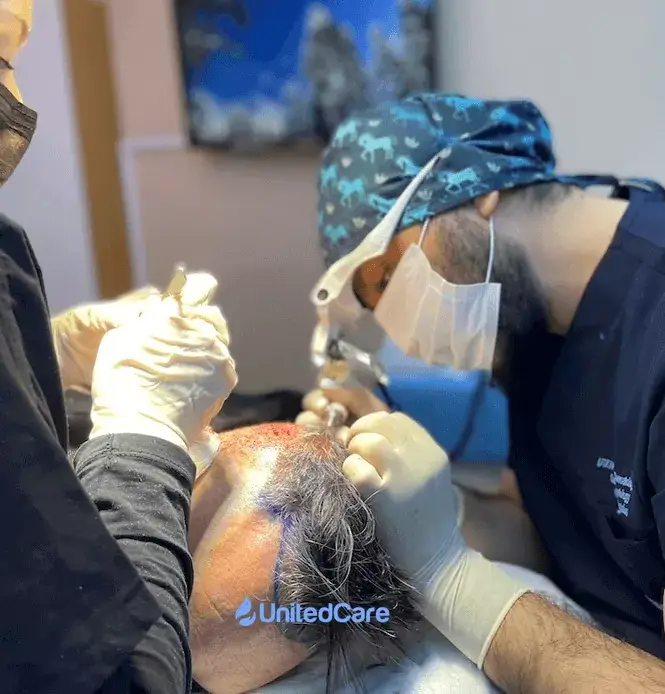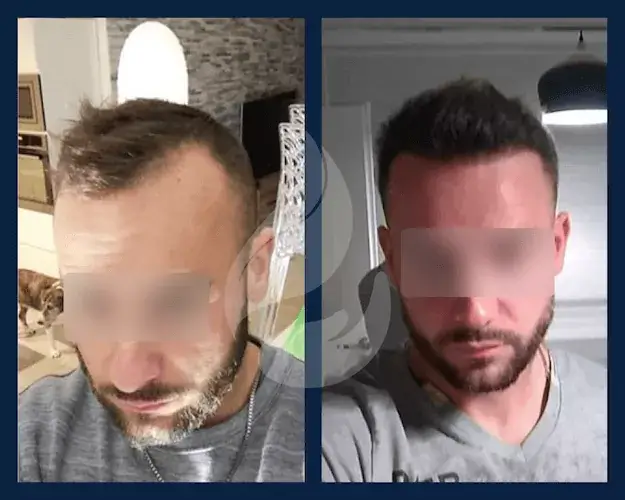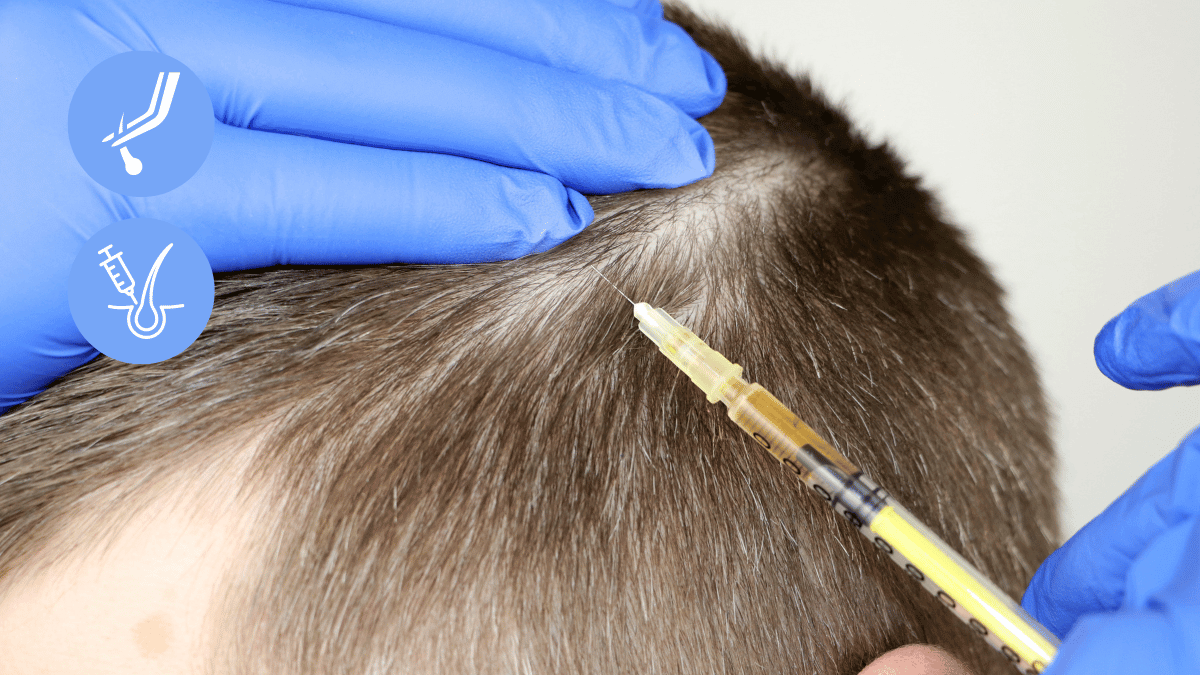Before we start, I want you to ask yourself: What exactly is a hair transplant to you?
Is it just like another regular health check-up at your local doctor, or is it the most significant investment you can make in yourself to look better than ever?
We believe in the second scenario. 🌱
And with such a precious investment at the line, we cannot allow pain to risk it all.
Luckily, we have a solution to make your transplant painless, allowing you to start the new, better version of your life smoother: Anesthesia.
Let’s delve into that.
In today’s article, I will talk about the possibility of painless hair transplants, which technique they are, why exactly pain happens in the first place, and how we prevent it:
Table of Contents
First of all, we promise you a painless hair transplant, thanks to anesthesia, but without it, which one is painless on its own?
Which Hair Transplant Is Painless?
Honestly, none of the hair transplant techniques is entirely painless. However, the pain differs significantly between the methods.
In hair transplants, you have essentially two techniques you can choose from: FUT and FUE.
💠 The FUT technique is a bit older and less preferable than the others.
In this technique, your surgeon removes the strip of skin tissue from the back of the scalp to harvest grafts. And afterward, we use stitches to cover the skinless part and join two ends.
Ultimately, removing a strip of skin part is much more painful than FUE and increases your recovery time tremendously, keeping the pain alive longer.
👉 That is why the best, most common, and guaranteed method for hair transplants is FUE.
In FUE, hair follicles are extracted from the donor site individually using a micro motorized punch and forceps and then planted into the donor area.
✅ With these tools, FUE creates a more precise process without needing a strip of skin, which reduces any chance of pain even further.
However, despite these differences, the nature of a hair transplant’s surgery process comes with some phases that include pain:
What Causes Pain During a Hair Transplant?
Regardless of your chosen technique, most post-surgery pain and discomfort originate from two stages of a hair transplant surgery:
➡️ Harvesting.
➡️ Implanting.
Without proper anesthesia, these stages can cause pain during and after surgery.
In the harvesting stage, your surgeon must manually harvest the follicles from your scalp to be implanted. And whether an entire tissue is cut or the follicles are one by one, your scalp will be under physical stress.
This pressure will again emerge when your doctor begins planting the follicles in the implanting stage, which differs even less between different methods.
🍀 Depending on your chosen technique, these stages might differ slightly in pain. However, they are, without a doubt, present during harvesting and planting.
But aside from the differences in each technique’s stages, the primary factor for the amount of pain you experience is anesthesia:
Anesthesia and Painkillers to Minimize Pain
For administering in pre-surgery and during the surgery process, anesthesia is our essential tool in eliminating pain.
Before your surgery, your clinic will provide you with a consultation about your options. You will have different options for your comfort during the surgery and the effectiveness of the sedation.
👉 In other words, choosing the right clinic with multiple anesthesia options, proper consultation, and an anesthesiologist at-site is vital for minimizing your pain.
With your doctor’s examination of the flawless hairline for your surgery, you will have options. These options can be the usage of local anesthesia, such as sedative tumescent anesthesia, or using sedation altogether, which will require an anesthesiologist and cost more.
💠 If you choose local anesthesia, your doctor, preferably an expert dermatologist, will use a needle-free dermojet during anesthesia implantation to reduce discomfort.
💠 Alternatively, if you choose sedation, your clinic’s anesthesiologist will help you gently fall asleep during the surgery and help the surgery run smoothly.
In either case, your chosen method will be first used for numbing your muscles in the harvesting stage:
Harvesting Stage

During harvesting, your head muscles will be numbed in two places:
1️⃣ Numbing the donor area where we take the grafts from during harvesting.
2️⃣ And numbing the recipient area where we will transplant those hair grafts during implantation.
In the first stage, we inject your chosen anesthesia into the donor area and numb your muscles. Alternatively, the anesthesiologist is present for your sedation. Once the scalp is numb, you will feel nothing throughout the process. This numbness will last approximately 3 hours.
💉 Thanks to the needle-free dermojet, the injections are quick and small, so the pain you experience during the injection will be minimal. This feeling is no worse than a fly bite, quickly followed by numbness as the medication kicks in. After you are injected, your muscles will completely numb within seconds to minutes.
After extracting the grafts, your follicles will be stored for later use. Those stored follicles will then arrive, once again with anesthesia, in the implantation stage:
Implantation Stage
This time, your chosen anesthesia technique will affect the recipient zones. The overall process, however, goes the same as the harvesting stage.
We move on to the second stage of numbing your scalp and start the implantation stage.
👍 Using the needle-free dermojet, we re-implant the stored follicles into your balding areas. The worst pain you can potentially feel here (unless you have chosen sedation by the anesthesiologist, in which case you will not even feel that) is the discomfort of sitting in the same place for a long time.
And for the past-surgery process, we have painkillers:
Post-Transplant
The first few days after the surgery, during the initial healing, you will feel temporary pain and overall discomfort around your scalp, as it is the most common side effect of a hair transplant.
But that is why painkillers are prescribed for this period, so you will not experience much during these days. After the first 2 to 3 days pass, you will not even need painkillers.
Once you’re off the painkillers, you should still expect minor pain and discomfort, but it is mild for most patients.
⚠️ If the pain persists, however, you should see your doctor immediately, and only with their consultation can you continue using over-the-counter painkillers.
In short, it is natural to expect some pain after a hair transplant surgery, which is why we have painkillers. And as long as you take them regularly as your doctor has instructed, you do not have to worry about experiencing pain.
If you’re still unsure about the process, the best way to resolve it is by getting professional help:
Get a free consultation now 🩺

At UnitedCare, we begin your hair transplant process by offering you a free one-on-one consultation with our expert doctors to determine your suitability.
💊 If so, our holistic approach provides advanced technologies and bio-enhancements to ensure you do not need another surgery.
Once you have decided on a method, we begin the treatment with the utmost attention.
But most importantly, we stay in contact with our patients even long after the surgery, ensuring that your transplant becomes permanent.
Affordable hair transplant costs, a holistic approach, and experienced dermatologists on-site are here to provide you with the right solution.
Ready to begin the journey? Click here to start the first step with a free consultation:
Achieving a painless hair transplant is not a myth anymore.
Restore your natural look in the smoothest way possible with a Dermatosurgeon:
Frequently Asked Questions (FAQs)
Is FUT more painful than FUE?
In many aspects, yes. In the FUT technique, the surgeon removes a strip of tissue from your scalp to harvest the hair grafts. After that, this part is covered with stitches. Not only is this process quite painful, but the healing of this part takes entirely of time, keeping the overall pain alive for longer in the FUT technique. In FUE, your surgeon removes the hair follicles one by one, so there is no pain due to a skin tissue being removed. And also, because of that, you heal faster and experience less overall pain.
How painful is a hair transplant?
Technically, with proper anesthesia, a hair transplant includes almost no pain. But the procedure relies heavily on your chosen technique regarding how painful it can be. A hair transplant can be pain-free by choosing the FUE technique with proper sedation and medications.
Can a hair transplant be done without anesthesia?
Technically, yes. But not only do we not suggest it, but it is also likely that you will not be able to find any clinic that offers this. Because a hair transplant surgery, like every other surgery, is not medically viable without anesthesia, as the process can be pretty painful.

